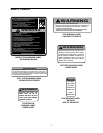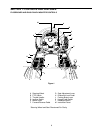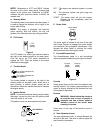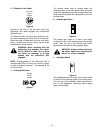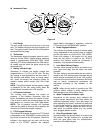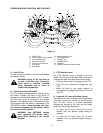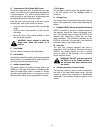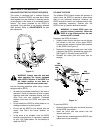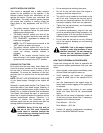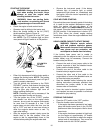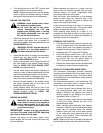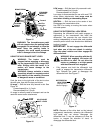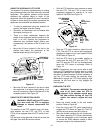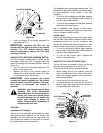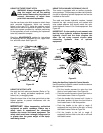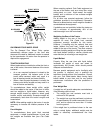
15
SAFETY INTERLOCK SYSTEM
This tractor is equipped with a safety interlock
system for the protection of the operator. If the
interlock system should ever malfunction, do not
operate the tractor. Contact your authorized Cub
Cadet Dealer. The safety interlock system prevents
the engine from cranking or starting unless the
brake pedal is fully depressed, and the PTO is
“OFF”.
• The safety interlock system will shut off the
engine if the operator leaves the seat before
engaging the parking brake.
• The safety interlock system will shut off the
engine if the operator leaves the seat with the
PTO “ENGAGED”, regardless of whether the
brake lock is engaged.
NOTE: The PTO switch must be moved to the
“OFF” position to restart the engine.
• The safety interlock system will shut off the
PTO if the reverse control pedal is depressed,
unless the reverse override function is
activated.
NOTE: If the reverse override function has
been activated, it will remain activated until the
ignition switch is turned to the "OFF" position.
FUELING THE TRACTOR
Fill the fuel tank with only clean, fresh, diesel fuel.
Fuel with a cetane number of 45 is recommended,
but fuel with a minimum cetane number of 40 is
acceptable. To ensure the freshness of the fuel,
purchase fuel in a quantity that can be used within
30 days.
NOTE: DO NOT USE KEROSENE OR GASOLINE
in your diesel engine. Damage to the engine will
occur.
Generally a good grade Number Two Diesel Fuel
should be used in your diesel engine. However, in
extremely cold temperatures a quality Number One
Diesel Fuel, or a blend of Number One and Number
Two Diesel fuels should be used. In most areas,
diesel fuel is properly blended for seasonal use as
ambient temperatures change. Therefore, it is
important to monitor fuel purchases so that
seasonal grade fuels are not carried over after the
average ambient temperature has changed.
WARNING: Never fill the fuel tank to
the top of the filler neck. Expansion
could result in overflow through the
vents in the cap, allowing fuel to come
in contact with the operator.
• Do not smoke while refueling the tractor.
• Do not fill the fuel tank when the engine is
running or while the engine is hot.
• The fuel fill cap is located on the fender to the
left of the seat. Unscrew the fuel cap and fill
tank from an approved container. Do not fill the
fuel tank to capacity. Allow room for expansion.
• Tighten the fuel cap securely, and immediately
wipe up any spilled fuel.
• To minimize condensation, keep the fuel tank
as full as possible without filling to capacity. It is
a good practice to fill the fuel tank at the end of
the day to reduce overnight condensation.
• Do not allow the fuel tank to run dry. Running
out of fuel requires bleeding air and repriming
the fuel system.
WARNING: Fuel in the engine injection
system is under high pressure. If not a
qualified mechanic, do not attempt to
service the fuel injection system. Do
not use your hand to check for leaks.
NEW TRACTOR BREAK-IN PROCEDURES
Proper care during the first hours of operation will
help to assure optimal performance from your new
tractor.
• Never operate a new engine immediately under
full load. Allow the engine to warm up.
• Avoid operating the engine for prolonged
periods at either high or low speeds with no
load.
• Use the transmission’s low speed range for
heavy loads to avoid lugging of the engine due
to overload.
• Closely monitor the engine oil and coolant
levels, and keep filled to the recommended
levels.
• After the first ten hours of operation, check all
of the front and rear wheel bolts. If necessary,
retighten to the following torque:
Front Wheels — 55 ft. lbs.
Rear Wheels — 80 ft. lbs.
• Perform all break-in maintenance procedures
found in the MAINTENANCE section.



